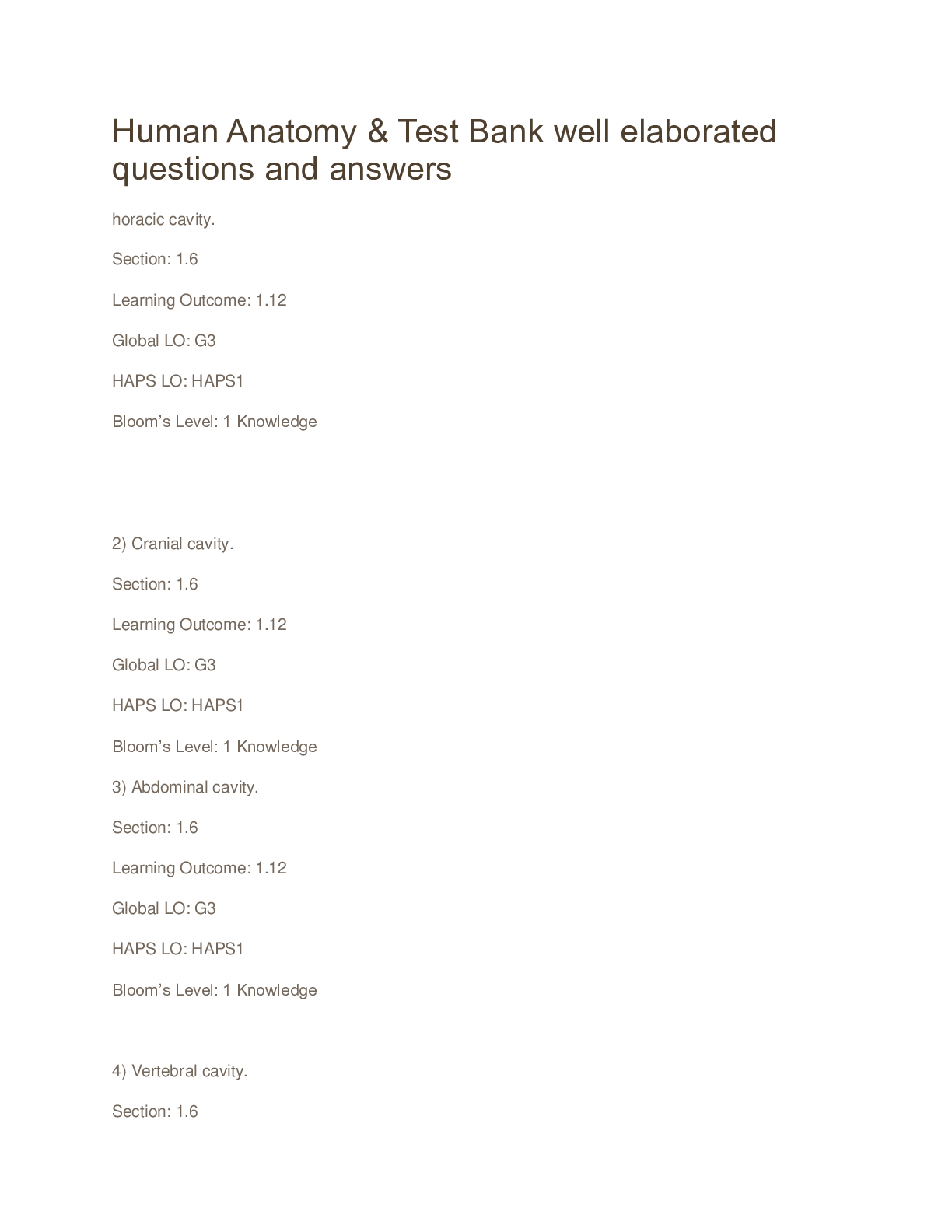Business > TEST BANKS > International Business Law and Its Environment Test Bank very detailed (All)
International Business Law and Its Environment Test Bank very detailed
Document Content and Description Below
1. The U.S. Constitution recognizes the states' power to make law in certain areas. TRUE The U.S. Constitution structures the relationship between the federal government and the states around the s... ystem of federalism, recognizing the states' power to make law in certain areas. AACSB: Ethics AACSB: Reflective Thinking Accessibility: Keyboard Navigation Blooms: Remember Difficulty: 1 Easy Learning Objective: 01-01 Identify the respective makers of the different types of law (constitutions; statutes; common law; and administrative regulations and decisions). Topic: Types and Classifications of Law 2. Uniform acts are model statutes drafted by private bodies of lawyers and/or scholars; they become law only after legislature enacts them. TRUE Uniform acts are model statutes drafted by private bodies of lawyers and scholars and do not become law until a legislature enacts them. AACSB: Ethics AACSB: Reflective Thinking Accessibility: Keyboard Navigation Blooms: Remember Difficulty: 1 Easy Learning Objective: 01-01 Identify the respective makers of the different types of law (constitutions; statutes; common law; and administrative regulations and decisions). Topic: Types and Classifications of Law 3. Common law is a state law and only state courts can apply it. FALSE Although common law exists only at the state level, both state courts and federal courts are involved in applying it. AACSB: Ethics AACSB: Reflective Thinking Accessibility: Keyboard Navigation Blooms: Understand Difficulty: 2 Medium Learning Objective: 01-01 Identify the respective makers of the different types of law (constitutions; statutes; common law; and administrative regulations and decisions). Topic: Types and Classifications of Law 4. The Restatements are considered binding laws and are promulgated by the American Law Institute. FALSE Restatements are promulgated by the American Law Institute, not the courts; hence, they are not considered binding laws. AACSB: Ethics AACSB: Reflective Thinking Accessibility: Keyboard Navigation Blooms: Remember Difficulty: 2 Medium Learning Objective: 01-01 Identify the respective makers of the different types of law (constitutions; statutes; common law; and administrative regulations and decisions). Topic: Types and Classifications of Law 5. According to the U.S. Constitution treaties made by the president with foreign governments and approved by two-thirds of the U.S. Senate validate inconsistent state and federal laws. FALSE According to the U.S. Constitution, treaties made by the president with foreign governments and approved by two-thirds of the U.S. Senate become "the supreme Law of the Land." Treaties invalidate inconsistent state and federal laws. AACSB: Ethics AACSB: Reflective Thinking Accessibility: Keyboard Navigation Blooms: Remember Difficulty: 2 Medium Learning Objective: 01-01 Identify the respective makers of the different types of law (constitutions; statutes; common law; and administrative regulations and decisions). Topic: Types and Classifications of Law 6. The same behavior will sometimes violate both civil law and the criminal law, and in such a case, both liabilities can be claimed at the same time. TRUE Even though the civil law and the criminal law are distinct bodies of law, the same behavior will sometimes violate both. In such a case, both liabilities can be claimed at the same time. AACSB: Ethics AACSB: Reflective Thinking Accessibility: Keyboard Navigation Blooms: Remember Difficulty: 1 Easy Learning Objective: 01-03 Explain the basic differences between the criminal law and civil law classifications. Topic: Types and Classifications of Law 7. A State Homicide statute is an example of a substantive law, criminal law, and public law. TRUE A statute making murder a crime is a rule of substantive law, while public law includes criminal law. Hence, a State Homicide statute is an example of all three laws. AACSB: Analytical Thinking AACSB: Ethics Accessibility: Keyboard Navigation Blooms: Understand Difficulty: 2 Medium Learning Objective: 01-03 Explain the basic differences between the criminal law and civil law classifications. Topic: Types and Classifications of Law 8. Though formal natural law defense is not recognized in court, judges may take natural law oriented views while interpreting statutes. TRUE While interpreting statutes, judges may try to see the impact of valid laws that result in a general welfare of society. AACSB: Ethics Accessibility: Keyboard Navigation Blooms: Understand Difficulty: 3 Hard Learning Objective: 01-04 Describe key ways in which the major schools of jurisprudence differ from each other. Topic: Jurisprudence 9. American legal realists distinguish between the "law-in-the-books" and the "law in action" and they recognize law as the behavior of public officials (mainly judges) as they deal with matters before the legal system. TRUE American legal realism defines law as the behavior of public officials (mainly judges) as they deal with matters before the legal system; and it is the actions of such decision makers that really affect people's lives. AACSB: Ethics AACSB: Reflective Thinking Accessibility: Keyboard Na [Show More]
Last updated: 2 years ago
Preview 1 out of 76 pages
.png)
Buy this document to get the full access instantly
Instant Download Access after purchase
Buy NowInstant download
We Accept:

Reviews( 0 )
$14.50
Can't find what you want? Try our AI powered Search
Document information
Connected school, study & course
About the document
Uploaded On
Jun 01, 2021
Number of pages
76
Written in
Additional information
This document has been written for:
Uploaded
Jun 01, 2021
Downloads
0
Views
72


.png)





_repaired (1).png)





